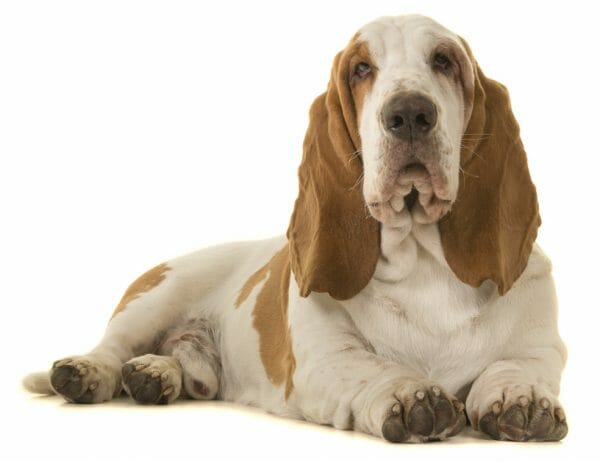Basset Hound

Basset Hound Temperament
Patient, friendly, and unassuming in temperament, the Basset Hound has made a name for itself across the country. Holding the titles of hunter, tracker, and companion, this all-in-one canine continues to capture the hearts of animal lovers the world over.
Basset Hound dogs (or “Bassets,” for short) are highly sought after for hunting and tracking. An uncanny sense of smell allows them to excel as scent hounds tracking down and capturing game.
These dogs do not back down easily from a hunt, often resolving to pursue game long after the scent has been lost. Loud, high-pitched baying and howling can be heard from these persistent hunters on the trail.
Despite the unwavering intensity of its desire to hunt, this pleasant canine is laidback and mellow in the home. A Basset Hound can make great family pets due to its good-natured, relaxed personality when not on the trail. This canine is also known to be wonderful with children and resolutely faithful to its family.
Physical Appearance
The Basset Hound’s unique physical features make it one of the most recognizable breeds of dogs. Though it is small in stature, the breed’s heavy-boned body is bulky, stout, and muscular. It possesses stubby but powerful legs that carry it effortlessly across hunting paths. Its large paws make it an avid digger. This canine’s tail is long and curves upward as it walks.

Miniature Basset Hound
In 2007, the miniature Basset Hound was created as a new breed of dog. Although a mini Basset Hound is considered a basset breed (which means it has short legs), the miniature Basset Hound is a separate breed called the Parva Os Lux Basset. Despite its size, miniature Basset Hounds are built to maintain the energy and endurance necessary to carry it through hours of fast-paced pursuit. Its narrow face, sad eyes, and furrowing brows give it a characteristically somber appearance. Low-hanging, floppy ears and drooping lips only add to this look.
European Basset Hound
The European Basset Hound is a variation from the American version of the breed. The primary differences between the two dogs is that the European Basset Hound is much larger (weighing a minimum of 75 pounds) and has more wrinkles and skin folds. However, both versions have similar color patterns and have the same predisposition to diseases.
Dimensions
Basset Hounds typically weigh between 40 and 80 pounds and have a height of up to 14 inches tall. It is important to note that, while the puppies are beyond puppyhood, their size remains that of a miniature Basset Hound until around 2 years of age. This is due to a more gradual maturation process.
Basset Hound Colors and Coat
 Short and flat to the skin, a Basset’s coat is silky yet dense in texture. The breed’s coat may come in a combination of one or more of the following colors:
Short and flat to the skin, a Basset’s coat is silky yet dense in texture. The breed’s coat may come in a combination of one or more of the following colors:
- White
- Red
- Brown
- Black
- Tan
- Mahogany
Finding a pure black Basset Hound is very difficult as most Bassets are tri-colored. Another rare coat color is the Lemon Basset Hound, which has almost blonde-colored fur.
Basset Hound Mix Breeds
Given its dangling ears, short legs, and distinctive melancholic expression, Bassets can create some unique-looking offspring when mixed with other breeds, such as:
- Beagles
- Labrador Retrievers
- Pit Bulls
- Corgis
- Shar Peis
- Dachshunds
- Cocker Spaniels
Miniature versions of this floppy-eared dog have also developed in various places. Careful consideration should be taken when producing hybrid dogs or animals in general. This is because of the increased potential for physical abnormalities, which often lead to medical issues down the road.
Basset Hound Rescues and Adoption Resources
A brief list of excellent adoption and rescue organizations for this breed are listed below:
- Basset Hound Rescue of Georgia
- Carolina Basset Hound Rescue
- Belly Rubs Basset Rescue
- Fur Kids Animal Rescue & Shelter
Whether one is looking for a miniature or standard size Basset, rescuing or adopting from a no-kill shelter are great alternatives instead of shopping for pets.

History and Background
The existence of Basset Hounds was first documented during the 16th century in the European countries of Belgium and France. Allegedly, friars residing at the Abbey of St. Hubert used dwarf-sized French hunting dogs to create the breed. The primary use of this scent hound was to accompany on-foot hunters in the pursuit of small and medium-sized game.
Because hunting was the preferred sport of the French aristocracy, mild interest in the new breed was soon sparked into a roaring flame across Europe. During the 1800s, the breed was crossed with arguably the best scent hound in the world, the Bloodhound. This not only produced larger dogs, but it elevated the olfactory senses exponentially, thereby making the Basset a more efficient tracker.
The mid-20th century saw the introduction of the breed to the United States, where it soon became a favorite in entertainment, on the trail, and in the home.
Fascinating Facts about Basset Hounds
 In spite of the popularity surrounding this universally-recognized canine, the following facts may be unknown to some.
In spite of the popularity surrounding this universally-recognized canine, the following facts may be unknown to some.
- Reflective of its heritage, the breed’s name is derived from the French word “bas,” which translates to “low.” This is not only in reference to its low-hanging ears but also its small stature.
- The official Basset Hound Club of America was established in 1935.
- Some sources claim that Bassets were reproduced from dwarf hunting hounds.
- At the conclusion of the American Revolution, the French military officer Lafayette allegedly gifted George Washington with Basset Hounds.
- Similar to the Bloodhound, Bassets possess world-class trailing and tracking abilities.
- In 1885, the breed made its debut in the American Kennel Club (AKC). The breed is in the top 25% of the AKC’s popularity chart–most likely because of their mild temperament.
- These canines lived with British royalty, including Queen Alexandra and Queen Victoria.
Grooming and Care
Despite the short length of its coat, the Basset Hound shed quite a bit during certain seasons of the year. Quick grooming sessions with a soft brush several times a week is recommended to keep this pup’s coat shiny and healthy.
The breed’s wrinkly face and hanging ears accumulate dirt build-up easily. Because of this, these areas will need particular attention. It is also important to remember these dogs tend to drool copiously, so frequent clean-ups may be needed.
Besides this, trimmed nails and bubble baths as needed will keep this pup looking shipshape.
Training
Due to a naturally stubborn, autonomous disposition, Basset Hound puppies can benefit greatly from early training in the areas of socialization and obedience. It is important to train Basset Hound puppies using treats and positive affirmations to help lock-in and cement good behavior. Harsh discipline is ineffective with these long-faced puppies.
Exercise
Although strenuous exercise is considered excessive when it comes to Bassets, a reasonable amount of daily exercise is needed. Moderate activity levels are advised not only to keep its need to hunt under control, but also to keep harmful weight gain (which it is prone to) at bay. It is important to begin a consistent exercise and training with Basset Hound puppies.

Common Health Problems
The typical Basset Hound lifespan ranges between 12 and 13 years.
The health issues listed below are those most characteristic of members of the Hound Group:
- Thrombopathia (a breed-specific inherited disorder causing unexplained bleeding)
- Elbow and hip dysplasia
- Entropion
- Ectropion
- Obesity
- Glaucoma
- Gastric torsion
In addition to regular visits to a board-certified veterinarian, the AKC recommends evaluating hips and eyes to rule out any issues common in those areas. Evaluations of this kind are best conducted on puppies to detect any unforeseen issues early in life.
Do you have a cute Basset Hound photo to share with our fans? Enter the cute dog photo contest today and we will add your story to our social media pages for everyone to see. Check out our other dog breeds. We’re adding new educational dog breed and health information every week.



